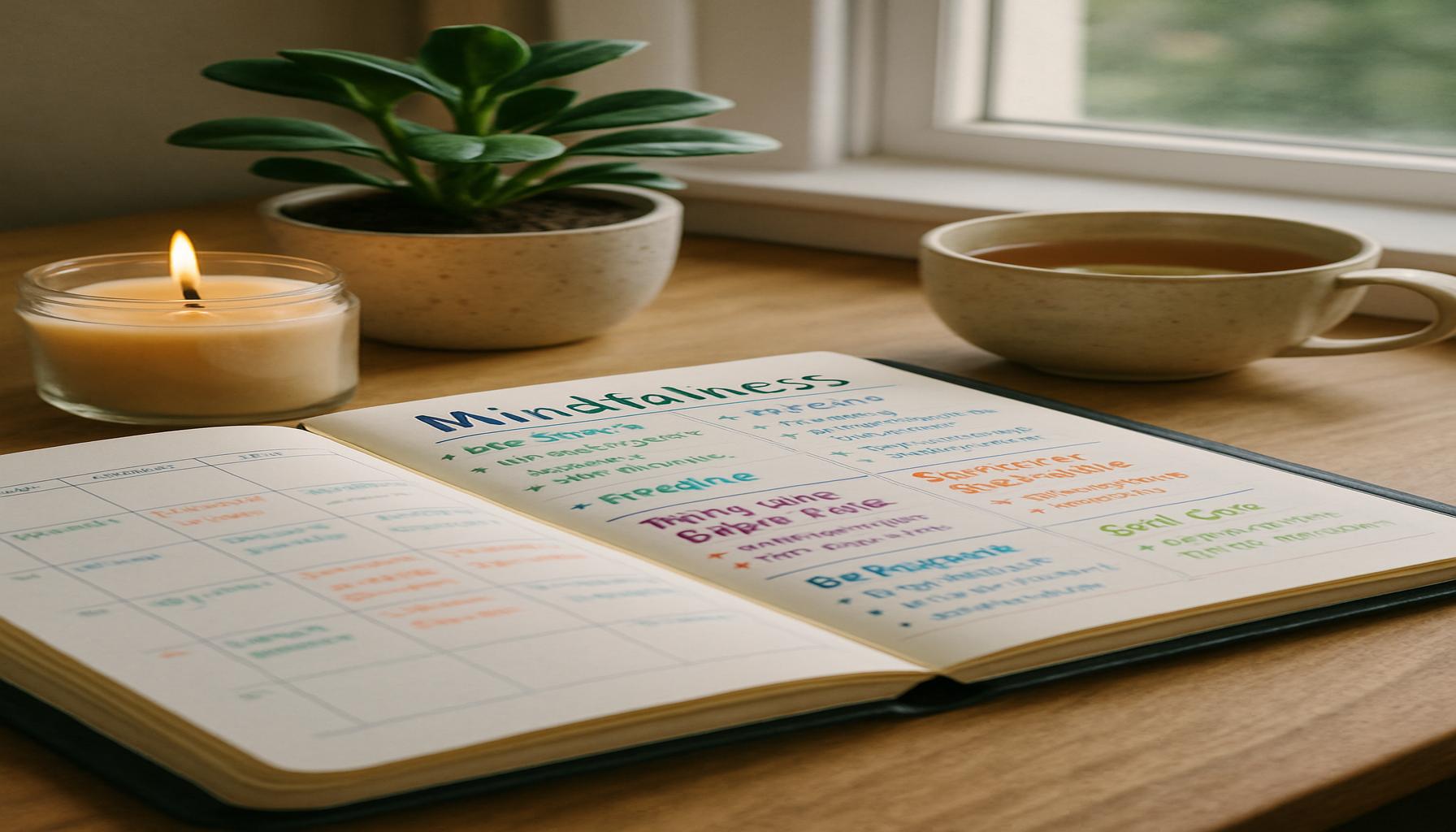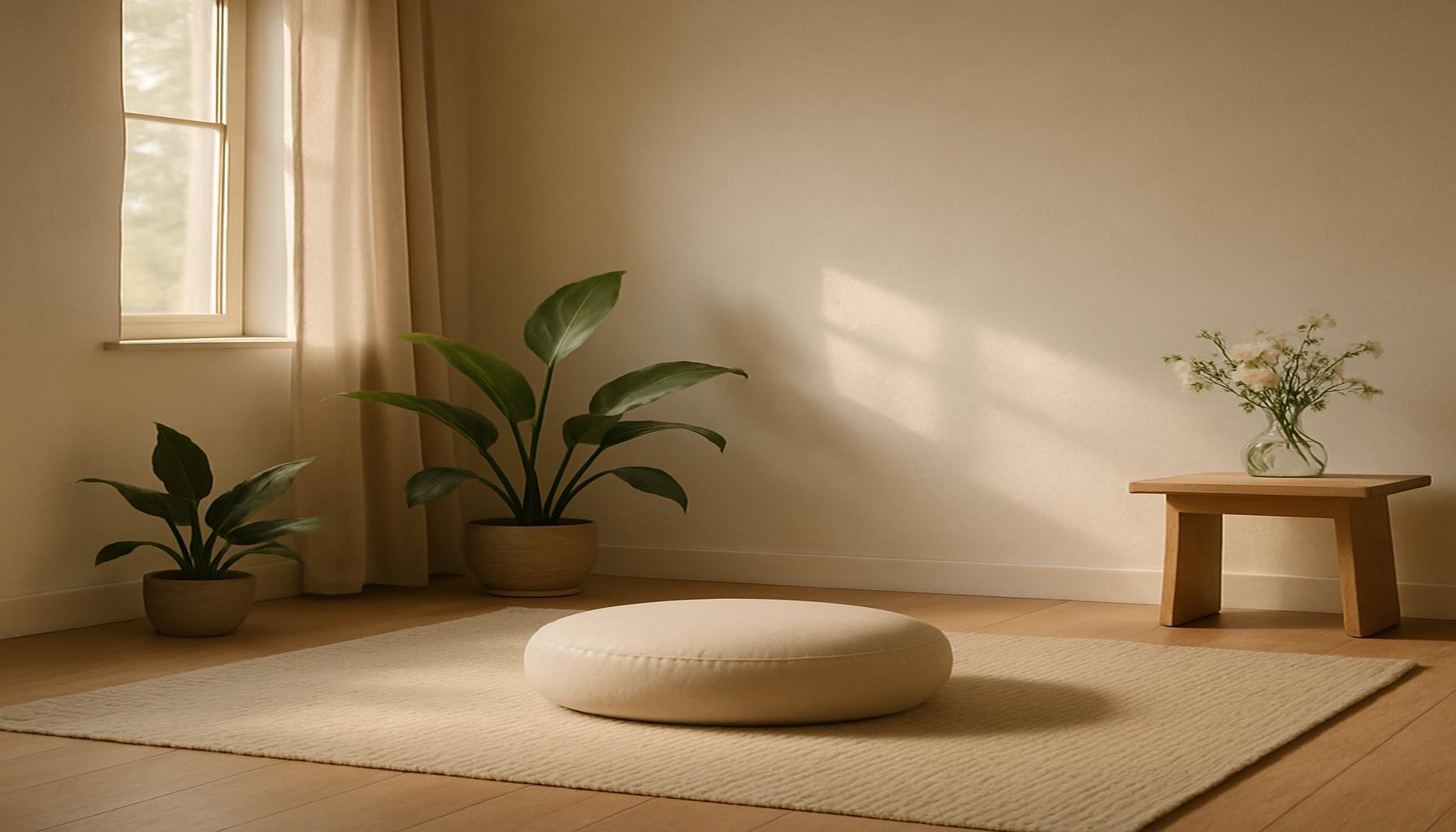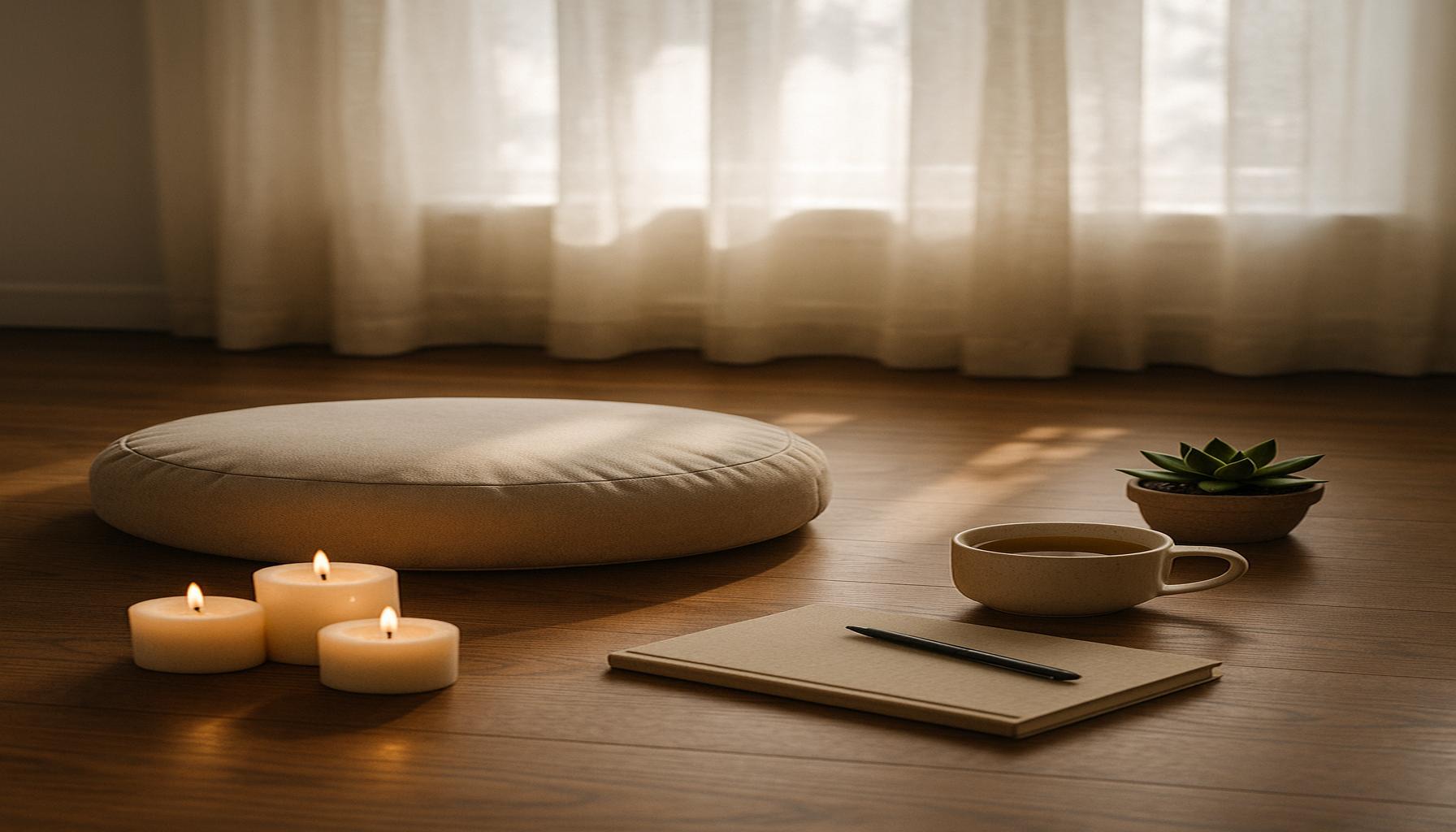How personal organization can be improved through mindfulness techniques

Understanding Mindfulness in Everyday Life
In the rush of modern life, it is not uncommon for individuals to feel overwhelmed. Between juggling professional responsibilities and personal commitments, many find it challenging to maintain an organized and balanced life. The pressures of deadlines, meetings, family obligations, and even the constant notifications from our devices can lead to a state of chaos. This is where mindfulness techniques come into play, offering a transformative approach to, not just manage time and space, but to enhance overall well-being.
The Essence of Mindfulness
At its core, mindfulness is about being fully engaged in the present moment without judgment. This conscious awareness can significantly enhance personal organization. For instance, one effective method of practicing mindfulness is through meditation, which can be as simple as dedicating a few minutes each day to sit quietly and focus on your breath. This practice not only calms the mind but also creates a mental space where clearer thinking can flourish.
Benefits of Mindfulness Techniques
- Improved Focus: Mindfulness practices train the mind to remain present, thereby decreasing the likelihood of distractions. This enhanced concentration allows individuals to devote their energy to important tasks, resulting in more efficient completion of projects.
- Enhanced Clarity: By engaging in mindfulness techniques, individuals can step back from overwhelming emotions or thoughts and evaluate their priorities with greater objectivity. This clarity can help in creating better to-do lists and setting realistic goals.
- Stress Reduction: Integrating mindfulness into your daily routine can considerably lower stress levels. Techniques such as breath control exercises or yoga encourage relaxation and help one to approach tasks with a fresh perspective, combating the sense of being overwhelmed.
Practical Integration of Mindfulness
Incorporating mindfulness into personal organization doesn’t require an overhaul of your lifestyle. Simple practices can be seamlessly woven into your day. For instance, a person might begin their morning by spending five minutes meditating before checking emails, allowing for a more mindful approach to the day ahead. Additionally, creating a mindful planning session each week to prioritize tasks can shift your perspective, keeping you focused and aligned with your goals.
Many people in the United States face the challenge of battling distractions in an increasingly digital world, where multitasking often comes at a cost to our effectiveness. By embracing mindfulness, individuals can find a sense of harmony, achieving not just productivity but also a deeper appreciation of their daily life. The marriage of mindfulness and organization paves the way for a structured yet flexible approach to living.
To truly reap the benefits of mindfulness, it’s essential to continually explore and engage with these techniques. As you cultivate this practice, you might discover a newfound sense of peace and purpose that can guide you toward a more fulfilling life. Whether you’re navigating a busy work schedule, dealing with family commitments, or simply trying to maintain a tidy living space, mindfulness can be a game changer.

DIVE DEEPER: Click here to learn more
Embracing Mindfulness for Enhanced Personal Organization
To understand how mindfulness can enhance personal organization, it’s crucial to delve into various techniques that foster this essential skill. One way to approach this is through the practice of differentiated awareness, which means recognizing what tasks truly require your attention versus those that do not. This nuanced understanding can alleviate the clutter of unnecessary obligations that bog us down, allowing for more meaningful engagement with the present moment.
Recognizing and Prioritizing Tasks
Mindfulness encourages a shift in our approach to tasks, fostering an awareness that illuminates our priorities. Harnessing this can lead to the effective establishment of priority lists based on urgency and importance. For instance, consider adopting the Eisenhower Matrix, a tool developed by U.S. President Dwight D. Eisenhower. This simple yet powerful framework categorizes tasks into four quadrants—urgent and important, important but not urgent, urgent but not important, and neither urgent nor important. By engaging mindfully with this matrix during your weekly planning, you can strategically focus your efforts on what truly matters.
Moreover, employing mindfulness means acknowledging when tasks feel overwhelming. By practicing mindful breaks, you can reset your mental state, allowing for a clearer approach to organizing your commitments. A simple technique is the 5-4-3-2-1 grounding exercise, which prompts you to identify five things you can see, four you can touch, three you can hear, two you can smell, and one you can taste. This practice can help reorient your thoughts and reduce anxiety, enabling you to tackle your organizational challenges with renewed energy.
Cultivating Intentional Routines
Creating intentional routines is another critical aspect of harnessing mindfulness for personal organization. Establishing a consistent daily routine can significantly enhance your productivity and decrease stress levels. For example, consider starting your day with a mindful morning ritual. This could include a brief period of journaling where you can outline your goals for the day. Writing down your tasks not only clears mental clutter but also reinforces accountability.
Additionally, integrating mindfulness into your organizational processes means being conscious of your environment. Keeping a tidy workspace can lead to heightened focus and reduced distractions. Studies suggest that a clean work area can increase productivity by as much as 20%. As such, periodically engaging in mindfulness practices—such as decluttering your desk—can yield significant benefits, providing a balanced and organized atmosphere in which to function effectively.
Integrating Mindfulness into Technology Use
As technology plays an integral role in our daily lives, practicing mindfulness while using digital tools is paramount. The hyper-connectivity of the digital age can lead to a fragmented attention span, making organization challenging. To combat this, one can use techniques such as digital detox periods, where specific times of day are dedicated to unplugging from devices. This practice not only helps manage distractions but also fosters greater clarity and focus when engaging with your tasks.
By embracing these mindfulness techniques, individuals can create a more harmonious relationship with their personal organization. Taking the time to be present and intentional in your approaches will lay the groundwork for increased productivity and a deeper appreciation for everyday life. Recognizing the power of mindfulness opens the door to a more organized, fulfilling experience that resonates beyond mere task management.
How Personal Organization Can Be Improved Through Mindfulness Techniques
Mindfulness techniques offer several pathways to enhance personal organization, leading to increased productivity and focus. One can harness the benefits of mindfulness to create a structured approach to daily tasks and responsibilities. By incorporating principles such as meditation, intentional breathing, and present-moment awareness, individuals can cultivate a mindset that fosters better organizational habits.
| Mindfulness Technique | Organizational Benefit |
|---|---|
| Meditation | Enhances focus and reduces distractions, allowing for clearer priorities. |
| Intentional Breathing | Promotes emotional regulation, aiding in better decision-making and time management. |
Utilizing these techniques can transform your approach to organization. When you practice meditation regularly, you become more adept at filtering out the noise that often clouds your judgment and adds unnecessary clutter to your daily schedule. Similarly, intentional breathing can anchor you during stressful moments, allowing you to remain composed and focused on the task at hand.
As you delve deeper into mindfulness practices, you’ll likely discover additional strategies to maintain an organized lifestyle. Journaling, for instance, adds a layer of reflection to your organizational techniques, encouraging personal awareness of priorities and tasks. This reflective process can help you align your actions with your personal goals, creating a synergistic effect that promotes sustained organizational improvement.
DISCOVER MORE: Click here to unlock the secrets of minimalism
Mindfulness Techniques for Streamlining Personal Organization
Once individuals begin to implement mindfulness in their lives, they can explore additional techniques that further streamline personal organization. One powerful method involves setting clear intentions. By taking a few moments each day to define what you want to accomplish, you create both a vision and a roadmap. This clarity is crucial, as it allows you to direct your energy toward those intentions rather than becoming distracted by extraneous tasks. Studies have shown that having clear goals enhances focus and productivity, significantly improving the likelihood of achieving desired outcomes.
Mindful Time Management
Time management can often feel like a never-ending battle. However, incorporating mindfulness into your scheduling can transform this area dramatically. Techniques such as time blocking, which involves allotting specific chunks of time to various tasks, can create a structured yet flexible framework for your day. By practicing mindfulness during your scheduled tasks, you can better monitor your progress and make quick adjustments as needed.
Another engaging method is the Pomodoro Technique, where one works for 25 minutes followed by a 5-minute break. This approach urges you to maintain laser focus on your work, and when coupled with mindfulness, offers a respite for reflection and reset. Engaging mindfully during breaks helps recharge your cognitive abilities, making you more effective in subsequent work sprints.
Mindfulness in Conflict Resolution
In any organized setting, conflicts and unexpected interruptions are inevitable. Mindfulness can significantly contribute to resolving conflicts effectively by ensuring you respond rather than react. When faced with a challenging situation, a deep breath and a pause can provide the necessary space to assess the problem at hand objectively. Using mindfulness practices such as active listening can enhance your understanding of differing perspectives, fostering collaboration and maintaining your overall organization.
Practicing Gratitude for Enhanced Focus
Embedding gratitude practices into your daily routine can further refine your organizational capabilities. Taking a moment to appreciate your achievements—no matter how small—can bolster your motivation and reaffirm your focus. Techniques such as keeping a gratitude journal can serve as a daily reminder of successes, thereby reinforcing a positive mindset crucial for effective organization. Research has shown that individuals who regularly engage in gratitude exercises report enhanced productivity and a decrease in stress levels, thus streamlining their organizational processes.
Mindfulness and Continuous Learning
Finally, the integration of mindfulness into personal organization is not a one-and-done approach. It demands consistency and openness to continuous learning. Mindfulness can help you become more receptive to feedback and more willing to adapt your strategies as new methodologies emerge. Joining workshops or engaging in online courses focusing on mindfulness and personal organization can also facilitate this growth. These learning experiences not only enhance your skills but also connect you with like-minded individuals who can further inspire your journey.
By incorporating these diverse and innovative mindfulness techniques, individuals can navigate the landscape of personal organization with greater ease and effectiveness. The journey encourages exploration and an open mind, paving the way for a more productive and fulfilling life where personal organization flourishes.
DIVE DEEPER: Click here to discover more
Conclusion: Embracing Mindfulness for Enhanced Personal Organization
In an increasingly fast-paced world, the challenge of maintaining personal organization is paramount. The integration of mindfulness techniques emerges as a powerful ally in this pursuit, fostering a sense of clarity and control over one’s daily life. The critical aspects highlighted throughout this article, including setting clear intentions, engaging in mindful time management, and practicing gratitude, underscore a holistic approach to organization that is both effective and sustainable.
By embracing mindful practices—from structuring your day with time blocks to appreciating daily achievements—individuals can significantly enhance their productivity without succumbing to overwhelm. The ability to pause and respond thoughtfully, particularly in conflict situations, enables not only personal growth but also nurtures healthier relationships in both professional and personal settings.
As you explore these mindfulness methods, consider that this journey calls for continual reflection and lifelong learning. Workshops, community discussions, and further readings can provide additional insights and keep you engaged in your organizational evolution. Implementing mindfulness into your routine is more than just a set of techniques; it’s a transformative mindset that empowers individuals to better navigate their responsibilities and ambitions.
As you move forward, let each mindful step guide you toward a more organized, focused, and fulfilling life, proving that the intersection of mindfulness and personal organization holds the key to achieving not only your goals but also a deeper satisfaction in everyday living.


